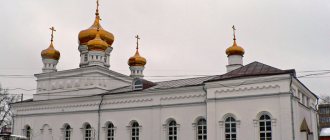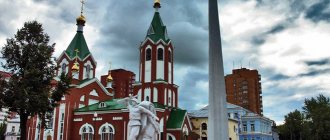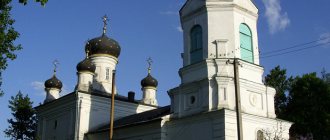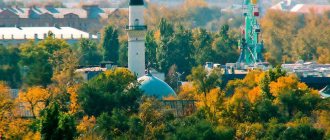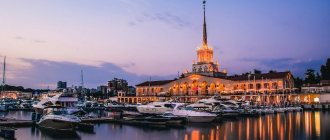Arena Mytishchi
Mytishchi Arena is a modern sports complex with 9,000 seats . The arena was built in 2001. Previously, games of the KHL regular season were held there, because the Atlant team played on the ice.
Currently, various sports clubs and sections for children and adults operate on the territory of the sports complex. Also on the territory of the Arena, a large number of citizens and guests of Mytishchi spend their leisure time skating. It has restaurants, banquet halls and cafes. After training, you can always sit comfortably and relax.
The Mytishchi Arena is conveniently located; you can easily get here by public transport or by private car.
Location: Letnaya street - 17.
What to see if you come with a child
In Mytishchi there are many different places that will not let little travelers get bored.
Einstein Museum
One of the city's shopping centers contains the Einstein Museum on its square, opened in 2016. The guides introduce the children to the laws of physics in a playful way:
The exposition of the institution includes 50 exhibits that can be touched, turned on and experimented with. You can also take a developmental quest if you wish.
Address: Kommunisticheskaya street, building 1, shopping center XL. Opening hours: 12.00–20.00, Saturday and Sunday – 10.00–20.00. The cost of visiting is 350 rubles.
Puppet theater "Ognivo"
The Ognivo puppet theater, opened at the beginning of the 20th century, will be a fascinating place for kids. Every year, about 16 thousand young spectators attend the theater's performances. At the entrance to the establishment there is a monument to “Ole Lukoje”, depicting a character from a famous fairy tale.
The Ole-Lukoje monument is a symbol of the Ognivo puppet theater
Address: Sharapovskaya street, 4/1. Ticket prices start from 340 rubles.
Water park "Kva-kva park"
The Kva-kva Park water park will not leave indifferent not only the child, but also his parents. The total area of the entertainment center is more than 4 thousand meters. There are slides of various lengths and heights, swimming pools and attractions. For very young children there is a children's playground where you can learn swimming.
Water park “Kva-kva park” is a favorite vacation spot for local residents and city guests
Address: Kommunisticheskaya street, building 1, shopping center XL. Opening hours: 9.00–22.00. Ticket prices start from 650 rubles.
Ice Arena "Mytishchi"
For young sports fans, the city has the Mytishchi Ice Arena. It was built in 2006 and is the largest sports facility in Mytishchi. In addition, the arena ranks among the best in all of Russia. Here you can go ice skating with the whole family, as well as visit one of the local cafes or restaurants.
Mytishchi Arena seats 7 thousand people
Address: Letnaya street, building 17. Skate rental - 150 rubles per hour; entrance ticket to the arena for adults - from 250 rubles, for children - from 100 rubles.
Church of the Annunciation of the Blessed Virgin Mary
This truly beautiful and majestic temple is located on the territory of the village of Taininskoye. This village was a favorite place for solitude of Ivan the Terrible, which served as his country residence. The temple was erected at the end of the 17th century. To this day, the atmosphere of that era hovers in it.
During the war with Napoleon, the temple was looted; later it was a store and warehouse, and only in 1989 it began to function again. The temple is beautiful not only outside, but also inside. In it, tourists will be able to get into the refectory and belfry, as well as see the altar. There is an atmosphere of calm and tranquility throughout the entire temple.
Location: Central Street.
Travel tips
Religious, architectural and cultural attractions of Mytishchi are available for exploration in both winter and summer. It is better to visit natural monuments in the warm season. Therefore, you should choose the period of your trip in connection with the goals you are pursuing.
How long does it take to look around Mytishchi?
You should set aside two to three days to get acquainted with all the significant places of the city:
Since you will have to spend more than one day in the city, you should book a hotel in advance. There are quite a few hotels in Mytishchi, and given the proximity to Moscow, you can spend the night in the capital.
What to bring as a souvenir
Tourists bring a variety of souvenirs from Mytishchi:
Monument to Nicholas II
Not far from the Church of the Annunciation of the Blessed Virgin Mary, on a hill, there is a monument to Nicholas II. It was opened in 1996. This date was not chosen by chance and coincides with the 100th anniversary of the accession to the throne of the last Emperor Nicholas II.
It’s terrible, but 6 years later the monument was blown up by people belonging to an extremist group. Three years later, in 2000, a decision was made to erect a new monument. The monument symbolizes the moment of Emperor Nicholas II’s ascension to the throne.
Location: Central Street.
Water park "Kva-Kva park"
For tourists tired of museums and monuments, Mytishchi is preparing another surprise - the largest water park in the city, “Kva Kva Park”. On an area of 4200 m2 there are slides for big and small, family pools and fun attractions. A children's playground opened its doors for young visitors.
The water temperature is maintained at the same level every day and is 29 degrees. There is a Greek restaurant on the territory of the water park, which happily offers all guests to taste European cuisine. There is also a SPA salon in the water park where you can relax and unwind.
Location: XL Shopping Center, Kommunisticheskaya Street - 1.
The first granite workshop with extensive experience
Monument B015
from 12760 rub.
Monument B163
from 55535 rub.
Monument B567
from 15080 rub.
Monument B522-1
from 20010 rub.
Monument B347
from 21170 rub.
Monument to VF230
from 45820 rub.
Monument B017
from 12760 rub.
Monument B128
from 20590 rub.
Monument B029
from 12760 rub.
Monument B452
from 18560 rub.
Monument B052
from 13775 rub.
Monument to VF520
from 32480 rub.
Monument B523
from 20590 rub.
Monument B645
from 20590 rub.
Monument B688
from 18560 rub.
Monument B629
from 19285 rub.
Monument B004
from 12325 rub.
Monument B449
from 18560 rub.
Monument B593
from 12760 rub.
Monument B713
from 118610 rub.
Monument B556
from 21025 rub.
Monument B060
from 13775 rub.
Monument B439
from 18560 rub.
Monument B335
from 21170 rub.
Monument B520
from 20590 rub.
Show all models
Moscow brewery
This is another favorite place for all tourists in the city of Mytishchi. And it’s clear why - the plant produces beer of the highest quality, the varieties of which are familiar to many.
There are daily excursions around the brewing company during which all guests are introduced to the production of products, told about the history of the plant and, most interestingly, everyone is invited to a tasting. Even if you are not a beer connoisseur, by visiting this excursion you will learn a lot of new and interesting things.
Location: Station Square - 2.
Church of the Nativity
This temple is the pride of the city. Its convenient location makes the temple noticeable from afar. It was built in a few months in 2001, but after serving the first service, it became clear that the temple could not accommodate such a large number of parishioners. The decision was made to expand it.
In this construction, the city administration was actively assisted by parishioners and city residents. Some volunteers bought bricks and wrote wishes and prayers on them; workers later used these messages to build walls. Now the temple occupies an area of 1500 square meters. m. and everyone can visit it.
Location: Novomytishchisky prospect - 6.
Church of St. Nicholas the Wonderworker
The church is quite young, built in the early 2000s. It is conveniently located near the Yaroslavl highway at the entrance to Elk Island. On its territory there is a garden with blooming roses and fruit trees, a greenhouse and even an apiary. The cozy and friendly atmosphere encourages peace and tranquility.
Location: Krasina street - 1A.
Sights of Mytishchi and description
Let's start our acquaintance with the natural monument of the city - the Yauza River. This is the left tributary of the Moscow River. The river is small, its length is 48 kilometers. It originates in the Moscow region, in the swamps of Losiny Ostrov. Ustye is located in the center of Moscow, near the Bolshoi Ustinsky Bridge. The area of the Yauza basin is 452 square meters. km.
At the beginning of the 18th century, from the mouth to Sokolniki, the banks of the Yauza were actively built up; its bed was blocked by numerous mills and dams. This greatly polluted its waters. In the 1930s, the river bed was leveled and almost doubled, granite embankments were erected along the reservoir, and new bridges appeared. The entire undeveloped part of the Yauza valley was declared a natural monument in 1991.
Elk Island National Park
This is a natural museum-reserve protected by the state. On its territory of 12,000 hectares there are coniferous forests and birch groves, ponds and lakes created by nature itself.
The park offers excursions where you can learn more about the area, see beautiful landscapes and get to know the main inhabitants of the island – moose.
Pestovskoye Reservoir
Another natural monument for which Mytishchi is famous. The sights of the city, which include the Pestovskoye Reservoir, were created by human hands. This is an artificial reservoir, built in 1937 during the construction of a hydroelectric complex on the Vyaz River.
The hydroelectric complex consists of a dam, 707 meters long, a catchment area and a bottom outlet. The reservoir area is 11.6 square meters. km, volume - 54.3 million cubic meters. The length of the artificial reservoir is more than six kilometers, the width exceeds two kilometers, and the depth is 14 meters.
The Pestovskoye Reservoir is part of the canal system named after. Moscow, the reservoir intersects with other reservoirs - Ikshinsky, Pyalovsky and Uchinsky. On its picturesque shores there are several marinas - Lesnoye, Tishkovo, Khvoiny Bor.
Mytishchi Historical and Art Museum
This museum is the central local history museum of the city of Mytishchi. It presents exhibitions of different times and cultures that previously lived on the territory of the modern city of Mytishchi. The guides will tell you about the history of the city, the mysterious village of Taininskoye, the construction of a water pipeline and many other interesting facts.
Location: Mira Street - 4.
SCHEME OF FVMK AND MAIN STRUCTURES
The entrance to the pantheon territory is marked by a pair of 32-meter steles. They symbolically reflect the different types of Armed Forces that we had during the Great Patriotic War: ground forces, the Air Force, the Navy and the rear of the army. Not far from the entrance is the Church of St. Sergius of Radonezh.
The War Memorial Cemetery is divided into several areas: an entrance area, a production area, a ritual area, and a direct burial area with a columbarium. The diagram shows the main structures of the complex.
Explanations for the diagram:
- checkpoint
- Obelisk of Glory
- Administrative building
- Pantheons
- Avenue of Heroes
- Ritual halls
- Arch of the Pantheon
- Eternal Flame Complex
Like any special facility, the memorial cemetery has a central entrance, that is, a military checkpoint.
From the entrance there is a central Alley, the length of which is over 2 km and the width is 10 m. A bridge is laid directly to the burials. It is constructed over a natural ravine, dividing the territory into almost 2 equal parts. The bridge symbolically separates life from death.
The continuation of the symbolic bridge is the Alley of Heroes. It depicts in strokes the past of our country from ancient times to the present.
It is decorated with 24 figures of warriors, cast in bronze and representing 6 main periods, starting from the soldiers of Dmitry Donskoy, and ending with the special forces soldiers of our days. On both sides of the central Alley, 15 elite segments have been allocated for the purpose of burying the Supreme Commanders-in-Chief of the RF Armed Forces.
In its surroundings along the entire length to the left and right there are architectural memorials, such as an underground hall of remembrance and pantheons. There was also space for a cafeteria, a funeral supplies store and a toilet.
A little away from the central Alley there is an administrative building lined with granite.
On the other side of the symbolic bridge, space is reserved for the ritual area, which contains a pair of similarly decorated mourning houses. One of them shows the core of the power.
The basis of its design is contained in the symbolism of the double-headed eagle and in the shape of the Kremlin towers. Another funeral home is decorated with military paraphernalia.
Behind the Arch is the final sculpture “Sorrow,” which depicts a mother with her warrior son dying in her arms. A bowl filled with water in front of the monument symbolizes sadness.
The central part of the water surface is crowned by the Eternal Flame, which seems to be bursting out of the water. Behind the sculpture, streams of water, like a mother’s tears, roll down the slabs into a round reservoir.
Monument to Mytishchi water pipeline
At the entrance to the city from the Volkovskoye Highway, a monument to the water supply system proudly stands. It was installed in honor of the 200th anniversary of the Russian water supply system in 2004. It consists of three pipes with valves twisted together. It is noteworthy that as you approach the monument, it visually becomes larger.
Location: Yubileinaya and Mira streets (at the intersection).
Drama theatre
Anyone who comes to Mytishchi can choose the attractions to suit their taste. Theatergoers will certainly be pleased to visit the FEST Theater. It appeared in 1977. This is the main theater of Mytishchi, which has been professional since 1988. Its history began in 1976, when the Komsomol committee of the MLTI announced an amateur art competition, in which the faculties of the Forestry Engineering Institute took part. Electronics students named their team "FEST". They presented the audience with the production “With Chile in Heart”. The performance featured then unknown, but today famous, E. Kurashov, O. Vinokurov, E. Tsvetkova, M. Zaslavsky, S. Demidov, P. Grishin. The boys took first place in the competition. Since that time, the FEST propaganda team appeared in the city.
Monument to a subway car
In the city of Mytishchi there is one of the largest factories in Russia for the production of railway cars, trams and metro cars. The plant bears the proud name “Metrovagonmash”. Not far from it is located this monument, interesting in its appearance. It shows how fast a subway car enters the tunnel.
Location: Kolontsova street.
Story
In ancient times, on the site of this city there was the village of Loshakovo. Over time, other settlements joined it, thus forming a volost.
At the end of the 18th century, Catherine II issued a decree according to which a gravity water supply system was to be laid from Mytishchi to Moscow. For a long time it supplied the city with water from the Mytishchi springs. The water pipeline began operating in 1804. In the 19th century, the first textile factories appeared here.
In 1860, Mytishchi turned into an important transport hub near Moscow, and the station village acquired the characteristic features of the future city. In 1896, one of the largest Russian factories for the production of carriages, which belonged to a group of industrialists, began operating in Mytishchi. In 1909, the country's first silk factory, Viscose, came into operation in Mytishchi. Soon a workers' settlement appeared near it.
In 1925, Mytishchi received official city status. A few years later, the surrounding villages were annexed to it - Sharapovo, Taininka, Rupasovo, Perlovka, Zarechnaya Sloboda.
Today Mytishchi is a modern, actively developing city. Its industry is represented by many sectors: mechanical engineering, production of finishing and building materials, light and food industries, instrument making, metalworking and others.
Monument to Family, Love and Loyalty
Walking through the cultural park, you can see this original monument, which was created by very young sculptors in 2011. This construction was dedicated to the day of Saints Peter and Fevronya, patrons of the family. On the monument, Peter and Fevronya extend their hands to each other, symbolizing love and unity.
Location: city park, Yauza embankment (on the left side).
Monument to the pilots of the Mytishchi flying club
In ancient times, near the village of Taininskaya there was a Mytishchi flying club. It once trained pilots and parachutists. Several club graduates received the proud title of “Hero of the Soviet Union.” Their names are carved on the memorial monument of the PO 2 aircraft rushing into the sky.
Location: Sukromka street - 7.
Mytishchi in the Great Patriotic War
Today, on the day of the 76th anniversary of the Great Patriotic War, we continue to publish chapters from the book of Mytishchi local historian and cyclist Sergei Egorov, “Historical Mytishchi from a bicycle.” We offer you a cycling route through the historical places of the city of Mytishchi associated with the Great War.
Until the 1960s, the city of Kaliningrad-Korolev was part of the Mytishchi district. Leonidovka was part of the Podlipki-Leonidovka group village council. Many residents who worked at the ZIK plant lived in Leonidovka. Therefore, there was only one military registration and enlistment office. Until the 1960s, people were drafted into the army, and even more so during the war, from the military registration and enlistment office of the village. Leonidovka.
The parades took place in Mytishchi. Therefore, the company’s employees gathered at the entrance and walked along the street. Lenin, Pionerskaya, Yaroslavl highway to Vokzalnaya Square in Mytishchi.
We are separated by the Yaroslavl highway, but we have a common historical memory.
Mytishchi during the Second World War.
Cycling route. Length 17 km. Mytishchi station - Silikatnaya st. - Leonidovka - st. Kolontsova - Yaroslavskoe highway - Druzhba microdistrict - Perlovskaya - Yauza recreation center.
The city of Mytishchi did not directly participate in the hostilities of the Great Patriotic War. The first line of defense of Moscow in October-November 1941 took place at a sufficient distance along the banks of the Klyazminskoye and Uchinskoye reservoirs, the Klyazma River, and the Moscow-Volga water canal. Nevertheless, the city was actively involved in ensuring the defense of Moscow: the 2nd (reserve) line of defense passed through it, elite special forces of the NKVD working in the German rear were stationed here, their schools and training camps were located, and defense enterprises operated at full capacity.
Route 4. Map 1.
We begin our cycling route on the square next to the Mytishchi railway station (on the left side of the railway from Moscow at point 1: 55.915188, 37.760308.) In 1941, recruits were sent to the front from this station. Trains with soldiers from Siberia and the Far East stopped there, who were then transferred to Moscow. Honorary citizen of Mytishchi, General A.P. Beloborodov, recalled how during a long stop of the train with troops of the 78th Infantry Division at the Mytishchi station on October 22, 1941, a meeting was organized with the participation of local residents, which strengthened the morale of soldiers and officers.
Monument to partisans on Vokzalnaya Square (not preserved). Photo 1963
From the station we move along Sharapovsky Proezd and Silikatnaya Street to building 1/9 ( point 2: 55.924144, 37.769180). In 1941, the 18th Fighter Battalion was stationed in the building of the Moscow Industrial College (now Lyceum No. 2), which not only performed security and counter-sabotage functions, but also participated in raids behind enemy lines.
The building is a former industrial college - the location of the 18th extermination battalion
We follow to point 3 (Silikatnaya, 19: 55.931394, 37.775594). This is the entrance to the enterprise of OJSC “Mostroyplastmass” (the former brick factory of the merchant Gerasimov, and since 1929 – the Silicate Brick Plant). During the war, the production of anti-tank mines was established there. In October 1943, a terrible explosion occurred at the plant, as a result of which it was completely destroyed. We cross Silikatnaya Street and approach the monument to those killed in the Second World War and in the explosion at the plant ( point 4 : 55.930691, 37.777747).
Monument to those killed in the explosion at the sand-lime brick factory
For experienced cyclists, we suggest driving to the entrance of the Dynamo shooting range ( point 5: 55.942087, 37.771645). During the war, there was a training base for the First Russian Special Forces - the Separate Special Purpose Motorized Rifle Brigade of the NKVD (OMSBON). The brigade has carried out hundreds of raids and special missions behind enemy lines, dozens of created partisan detachments, including the famous “Winners” detachment of D.N. Medvedev, in which the legendary intelligence officer N.I. Kuznetsov fought. The author's father Stepan Mikhailovich Egorov fought with the Nazis in the Frunze partisan brigade near the city of Osveya (Belarus) under the command of I.K. Zakharov. According to his recollections, part of their brigade was also formed from fighters of the Mytishchi OMSBON. Currently, the shooting range is private territory. And the question of access to it depends on the favor of the guards. You can drive around the territory from the outside, for example, to the Olympic entrance to the shooting range ( point 6 : 55.943434, 37.765424).
Not far from point 4, behind the railway, there is the Podlipki sanatorium (point 7: 55.937789, 37.810565, Yaroslavskoe highway, property 149). Here during the war there was a Hospital for 650 beds and a Higher School of Sappers and Miners for 125 people.
From point 4 we return to the beginning of Silikatnaya Street, cross the railway crossing at point 8 : 55.923474, 37.771819 and move along the street. Popova towards Yaroslavl highway. On the right side is the block of the Mytishchi city hospital, where the hospital was located during the war. At point 9: 55.924299, 37.784887 (13 Popova St.) there is a bayonet monument to those killed in the Second World War. The monument is located on the site of a one-story wooden building of the district military registration and enlistment office, in which conscription for military service was carried out during the war. More than 45 thousand of our fellow countrymen went to the front from this building.
City military commissariat in Mytishchi in the 1940s. Photo from S. Vetlin’s book “Mytishchi, the birthplace of Russian special forces.”
Monument-bayonet to those killed in the Second World War on the site of the former Mytishchi military registration and enlistment office
Following Khlebozavodskaya Street, we exit onto Yaroslavskoe Highway and climb the pedestrian bridge at point 10: 55.921323, 37.796067. From the bridge there is a view of the administrative building of artillery plant No. 88 (now RSC Energia OJSC, point 10 : 55.921762, 37.798245).
The administrative building of the former military plant ZIK N 88 (now RKK Energia) In 1941, the plant was evacuated to the Urals, and in 1942 Leningradsky was transported to its place. During the war years, the plant produced 5,400 25 mm 72-K automatic anti-aircraft guns.
Crew of the 72-K anti-aircraft automatic gun in position in 1943.
We drive along the Yaroslavl highway to the Church of the Icon of the Vladimir Mother of God ( point 11 : 55.910049, 37.774030). The church's bell tower was dismantled in 1941 so as not to serve as a landmark for enemy aircraft, and was restored only in the late 1990s.
Church of the Icon of the Vladimir Mother of God. 1713
On the left hand we pass the site of the former airfield of the Headquarters of the Supreme High Command ( point 12 : 55.911582, 37.784523). It was from this airfield that OMSBON sabotage and partisan groups were most often delivered behind enemy lines.
Airfield of the Headquarters of the Supreme High Command. German filming 1942
We drive 800 meters to the entrance of OJSC "Metrovagonmash" st. Kolontsova, 6, point 13 : 55.910457, 37.765751. The plant, which hid under number 592 during the war, was evacuated to Ust-Katav in October 1941. Despite the evacuation, armored caps and anti-tank hedgehogs continued to be produced on its territory. And since 1943, using new equipment, the plant began to produce self-propelled artillery units SU-76, which became famous in the battles on the Kursk Bulge. The monument to the legendary self-propelled gun rises opposite the entrance of the plant.
Self-propelled gun SU-76 at the entrance of OJSC Metrovagonmash
SU-76 in Berlin
SU-76 in combat
At the neighboring enterprise, the Viskosa factory (5 Kolontsova St., point 14: 55.913395, 37.763674), the production of parachute silk and lines was established. And since 1943 - cellophane - film that was urgently needed at the front.
We return to the Yaroslavl highway along Kolontsova Street, which in the 1940s was the main street of Mytishchi, and military parades and demonstrations were often held there.
Military parade on Kolontsova Street in the 1940s
We cross the Yauza along the pedestrian bridge and follow the sidewalk along the highway (unfortunately, it is not finished everywhere yet) towards Moscow to another example of defense products of the former plant No. 592 - the Shilka self-propelled anti-aircraft gun ( Point 15: 55.903611, 37.759265).
Anti-aircraft gun ZSU-23-4 "Shilka"
Route 4. Map 2
We continue driving behind the noise barrier to the overpass ( point 16 : 55.892152, 37.743443). We cross to the other side of the highway and along 1st Parkovaya and Krasina streets we approach the Church of St. Nicholas the Wonderworker, consecrated in 2003 ( point 17: 55.889713, 37.750065). On the site near the temple there are two reinforced concrete fireplaces (reinforced concrete firing point). One has been preserved in this place since the Second World War. At that time there was no church, no shopping center, and a significant section of the Yaroslavl highway was freely shot from the reinforced concrete construction. The second ZhBOT was recently “rescued” by local historians from the swamps of Losiny Ostrov.
Reinforced concrete pillbox near the Church of St. Nicholas the Wonderworker
Reinforced concrete pillbox near the Church of St. Nicholas the Wonderworker
We return to point 16 and along the streets 5th Yaroslavsky Lane, Pozharny Proezd, 2nd Baumanskaya, 1st Vokzalnaya we continue moving towards the Perlovskaya platform. We cross the railway along a pedestrian crossing, and to the right of it we see another reinforced concrete guard, guarding the approaches to the railway ( point 18 : 55.893094, 37.730223).
Reinforced concrete bunker near the Perlovskaya platform
Approximately 400 meters northeast of ZhBOT at point 19: 55.896394, 37.734874 in the sanatorium named after. Semashko (now does not exist) housed the Military Hospital.
Along the street of Hero of Russia Vera Voloshina, a student at the Institute of Cooperation, who repeated the feat of her friend Zoya Kosmodemyanskaya, and was executed on the same day as her - November 29, 1941 (the monument-bust to the hero is located at coordinates 55.893464, 37.725117, Semashko Street, 22), we are moving towards the second line of defense of Moscow, which took place in Mytishchi along the Yauza River. We turn right onto 1st Krestyanskaya Street, and then onto Sosnovaya. Here, at point 20 : 55.897186, 37.727002, one of the reinforced concrete tanks that defended this line was preserved.
Reinforced concrete bunker on the bank of the Yauza at point 20
From point 20 you can make a radial exit from the route to the former territory of the Mytishchi airfield of OSOAVIAKHIM. In 1941, the airfield was subordinated to the NKVD and was used to send sabotage groups behind Nazi lines and train paratroopers. The site of the airfield is immortalized by a monument to the PO-2 aircraft ( point 21: 55.903420, 37.714788).
Monument to the PO-2 aircraft
The monument can be reached along 1st Krestyanskaya, Sukromka, Letnaya streets. The eastern border of the airfield ran along Letnaya Street, and the western border approximately along the street. Anniversary. At the intersection of the latter with Veterans Boulevard, a monument was erected to the Honorary Citizen of Mytishchi, Hero of the Soviet Union, pilot, “night witch” N.M. Raspopova ( point 22 : 55.910854, 37.715094).
Monument to N.M. Raspopova
We continue moving along the Frontier of Defense to the north along the recently opened bicycle path along the Yauza, then along the streets Naberezhnaya, Rabochaya, Mira to another well-preserved reinforced concrete plant at point 23: 55.906385, 37.743090.
Reinforced concrete works near Mira street
The route ends at the Military Memorial of Mytishchi at point 24 : 55.907721, 37.742485. The memorial complex was opened on May 9, 1995, and on May 9, 2005, the Eternal Flame was lit at the foot of the majestic stele. Let us bow to the fallen heroes and honor their memory with a minute of silence.
War memorial in Mytishchi
In describing the route, we did not mention several important objects of the city's air defense: anti-aircraft gun positions at the Yauza Palace of Culture, the FEST theater, school No. 25, on Furazhnaya Street; floodlight installations near school No. 25 and on the modern territory of the Russian University of Cooperation, balloon barriers in the area of the Perlovskaya platform; one of the first radar stations in the USSR “Redut 40”, which operated near the village of Yadreevo (in 1941 there were only two of them near Moscow). There are practically no traces of them left. We can only approximately name the place where they were.
The first Soviet radar station is on duty. Photo 1941
Sergey Egorov, member of the Union of Local Historians, member of the Public Chamber of the Mytishchi Urban District
Sources:
- From the book “Historical Mytishchi from a bicycle” by Sergei Egorov (forthcoming).
You can also read in the newspaper “A Week in the District”:
- No. 17 from 6.5-12.5.2017 “Mytishchi in the Second World War.” Cycling route part 1.
- No. 18 from 13.5-19.5.2017 “Mytishchi in the Second World War.” Cycling route part 2.
Views: 11,449




